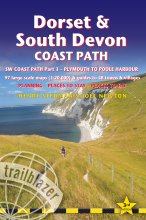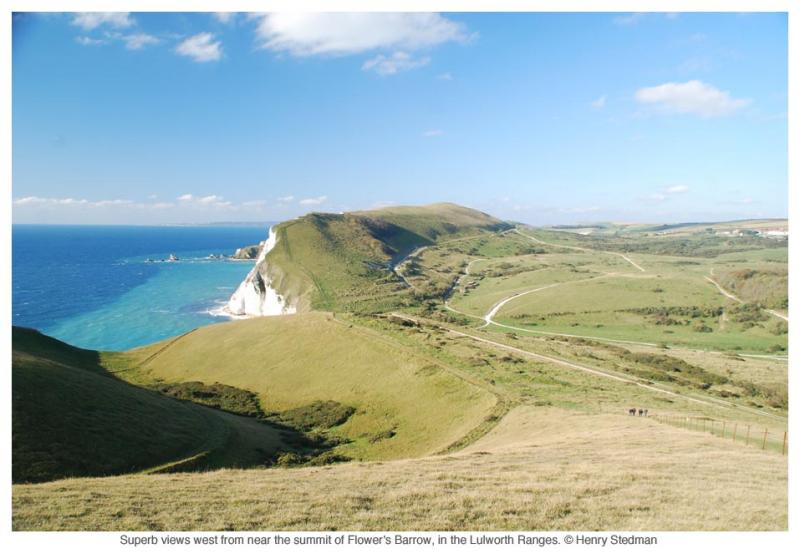Practical guidebooks for the more adventurous traveller.
— The Herald

Dorset & South Devon Coast Path (South-West Coast Path Part 3)
Excerpt:
Introduction
Contents | Introduction | How difficult is the path? | Planning your walk | Using this guide | Sample route guide: Bigbury-on-Sea to Salcombe
INTRODUCTION
This book covers the last 217 miles (350km) of the South-West Coast Path (SWCP), Britain’s longest national trail. The walk described begins on the Devon–Cornwall border, at Plymouth and, having navigated Devon’s entire southern coastline, enters the county of Dorset at Lyme Regis, before finishing at South Haven Point, overlooking Poole Harbour. Together with the two other books in this series, the entire 630 miles of the SWCP is covered.

There are few, if any, stretches of the British coastline that can offer the walker such variety, such interest – and such beauty – as this third and final leg of the coast path. From sun-drenched promenades to wild, remote cliff-tops, through ancient ‘apple-pie’ villages, tiny thatched hamlets and smart, friendly Georgian resorts, this path has it all. Indeed it is difficult to think of another section of any national trail that so comprehensively lives up to that well-worn cliché of the travel industry: that there is something for everyone. For historians the trail begins – most appropriately, given the many famous journeys that have departed from the same spot – at the Mayflower Steps, in Plymouth’s timeless Barbican district, and passes through such fascinating towns as medieval Dartmouth, home to the UK’s only Royal Naval college, and Teignmouth, the last place in mainland England to be successfully invaded by a foreign power. Castles, caves, barrows, burial mounds, ships, stone circles, historic harbours and old hostelries – all lie on the path, and all offer something to intrigue and captivate the history buff.
Similarly, geologists also have plenty that they’ll find engrossing – and indeed you don’t need to be an expert in stone or strata to enjoy them. Not only is the English Riviera (see box p153) the home of a Global Geopark but across the River Exe there’s The Jurassic Coast World Heritage Site, where the very rocks you step on can take you on a 185-million-year geological journey. Steep and precipitous cliffs of orange, grey and white change their hue with each passing geological era; and if these don’t ‘rock’ your world, within these very cliffs are the fossils of strange and unfamiliar beasts that once dominated the Earth: a long-vanished land of soaring pterodactyls rather than swooping peregrines, where plesiosaurus, not porpoise, cruised the seas, and the endemic scelidosaurus once roamed where sheep now ruminate.
The wildlife of today is not without its merits either, from the lovely deer of Lulworth to otters in Axmouth. And while man has done more than his fair share of shaping and utilising the land you pass through, he has also been careful to protect it too, with numerous Sites of Special Scientific Interest, several nature reserves and no fewer than three Areas of Outstanding Natural Beauty – with each encompassing mile after mile of epic panoramas, jagged sea stacks, and bountiful, beckoning beaches. There are also such spectacular delights as the curious Undercliffs, moulded by landslides and decorated by the free hand of nature into a truly English jungle; the south coast’s highest point, Golden Cap; and the iconic natural architecture of Durdle Door, Stair Hole and Lulworth Cove.
But if all the above sounds a bit too worthy, for those after less cerebral pleasures the path also cuts through such quintessential seaside resorts as Exmouth, Sidmouth and the English Riviera (Torquay, Paignton and Brixham) – a land of doughnuts and dodgems, arcades and amusements, candy floss and crazy golf.
Another joy of the coast path is the food, with fish in Brixham so fresh you can taste the salt of the ocean. Crab sandwiches, pints of real ale and cream teas galore can be savoured all along the path, especially in the thatched villages of Beer, Abbotsbury and West Lulworth, all of which prove that nature doesn’t have the monopoly on beauty and defy you not to change your plans and spend a night in their cosy embrace.
Of course such rewards aren’t gained without a fight, and there are a couple of tough stretches of walking that must be completed before you can say that you’ve conquered the path. But those of you who started in Minehead, the beginning of the SWCP, will know that, whatever the hardships faced, the treasures of this wonderful, endlessly fascinating path, are always – always! – worth any effort expended.
Dorset & South Devon Coast Path (South-West Coast Path Part 3)
Excerpts:
- Contents
- Introduction
- How difficult is the path?
- Planning your walk
- Using this guide
- Sample route guide: Bigbury-on-Sea to Salcombe
Price: £13.99 buy online now…
Latest tweets